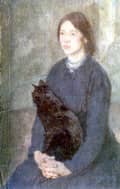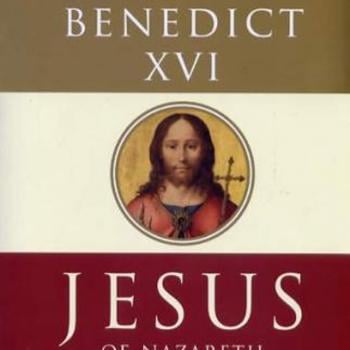The Italian masters of the Renaissance painted what they were asked to paint; some of them were pious men, others were notorious unbelievers or, at least, suspected of unbelief. At any rate one does not detect any definite relationship between artistic talent and religious faith. A very pious man can be a very poor artist and his talent does not improve if he decides to build a church, to write a Mass, to compose pious verse or to paint religious subjects. As an artist, he remains just what he is.
 Thus there is no fear or hesitation in affirming the distinction between the two orders -- art and faith. Nor is there any difficulty in accepting Cecily Langdale's opinion that for John, the churchgoers at St. Michael's in Meudon -- whom she sketched from her seat in the rear of the nave -- were "merely objects" upon which her trained eye happened to fasten. Yet, unlike Gauguin, the unbeliever, whose The Yellow Christ evoked the pieties of Breton peasants "from without," in Gwen John's case, the few programmed "religious subjects" that she painted were necessarily done "from within." Thus in certain cases -- for example her masterpiece, Mère Pouseppin, an updated portrait of the 17th-century foundress of the Dominican Sisters of the Presentation, or her numerous drawings of St. Thérèse of Lisieux -- we find a masterful technique placed in the service of devotional Catholicism.
Thus there is no fear or hesitation in affirming the distinction between the two orders -- art and faith. Nor is there any difficulty in accepting Cecily Langdale's opinion that for John, the churchgoers at St. Michael's in Meudon -- whom she sketched from her seat in the rear of the nave -- were "merely objects" upon which her trained eye happened to fasten. Yet, unlike Gauguin, the unbeliever, whose The Yellow Christ evoked the pieties of Breton peasants "from without," in Gwen John's case, the few programmed "religious subjects" that she painted were necessarily done "from within." Thus in certain cases -- for example her masterpiece, Mère Pouseppin, an updated portrait of the 17th-century foundress of the Dominican Sisters of the Presentation, or her numerous drawings of St. Thérèse of Lisieux -- we find a masterful technique placed in the service of devotional Catholicism.
Religion, in fact had a central role in the life of Gwen John. Vera Oumançoff told Sir John Rothenstein that John was "a very practicing Catholic, she received Holy Communion every day." Cecily Langdale recounts the correspondence between Gwen John and Jesuit Father Martin D'Arcy. It was his book, The Mass and the Redemption that peaked her theological interest and moved her to write him. He reciprocated in two letters. Still, her primary calling was to her art, not theology. Maritain is at pains to challenge Wyndham Lewis's assertion that Gwen John "belonged to the Catholic Revival in France." "Considering her total solitude," Maritain reacted, such a view was "senseless." The philosopher is adamant in denying that he was ever a "friend" of Gwen John or that she had participated in the Maritains' Thomist circle at 10 rue du Parc.
Yet it is not only the connection between art and faith in Gwen John that we find absorbing; it is the way in which both of these things found a home within a personality in turbulence. John's obsessive side; her moments of pride followed by deep insecurity; the perfectionist impulse that made her hesitate to part with commissioned pieces, giving rise to the "myth" that she abhorred exhibiting; her fixation on Rodin and then Vera -- while, at the same time, treating the world well lost -- each series of polarities makes her own portrait terribly contemporaneous. Her struggles ring with an immediacy for us. It was for this reason that John Rothenstein recalled a comparison with Pascal and Newman. He noted the quality in the many sheets of cribbed prayers that she left behind, interspersed between penned quotations from the saints and the poet Baudelaire.
She lacked, constitutionally, any ability to adopt as a rule the developing spirit of communality that the popes were urging upon the Church. In the face of the corporateness that was coming of age in the social encyclicals, John had only her fierce and lonely artistic habitus to offer. Although a daily communicant, who brought her sketchbook to church, John admitted how she loved the humble parishioners of Meudon as long as she didn't have to speak to them.
For most of the cognoscenti of the art world, the faith of a painter is of no point. John might as well have been a theosophist or an adept of automatic writing. But she was a Catholic, and in the words of her biographer, gallery owner Cecily Langdale, "though perhaps a minor one, she must nonetheless be acclaimed as an enduring master."
This piece first appeared in the September 1995 issue of Crisis Magazine, and is reprinted here with permission by InsideCatholic.com.




